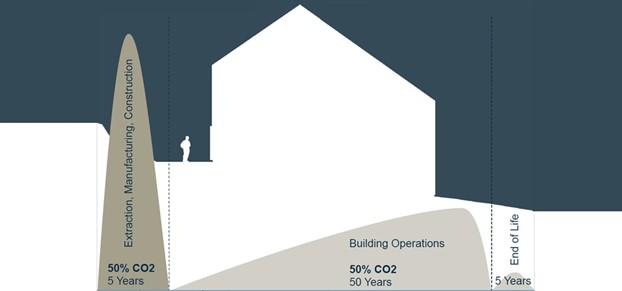Reducing Embodied Carbon: Sustainability at the Heart of the Royal BC Museum’s PARC Campus
December 2024

Sustainability plays a central role in the design and construction of the Royal BC Museum’s PARC Campus. The aim is to reduce both operational carbon emissions—those generated during the building’s operation, such as from heating, cooling, and lighting —and embodied carbon emissions, which stem from the materials selected and processes used during construction.
Why Focus on Embodied Carbon?
The United Nations Environment Programme identifies the building and construction industry as the largest emitter of greenhouse gases (GHG), responsible for approximately 40% of global emissions.
In Canada, embodied carbon is estimated to represent up to 50% of a building’s total carbon emissions over its entire lifecycle. Half of these emissions are released during the construction phase[1].
A large portion of these emissions is driven by the use of carbon-intensive materials like concrete, steel, and masonry, which require significant energy to produce, leading to high GHG emissions. In response to this challenge, the Royal BC Museum is taking a proactive approach to minimize both operational and embodied carbon in PARC Campus.
A Commitment to Sustainability at the PARC Campus
Aligned with British Columbia’s sustainability goals, PARC Campus is being designed as an all-electric facility, pursuing LEED Gold certification[2]. This design approach promotes energy-efficiency and low operational emissions, contributing to a cleaner, greener environment. However, the Royal BC Museum is going a step further by also focusing on reducing embodied carbon, the first provincial project to undertake such a comprehensive approach.

The first critical step with this approach was setting an embodied carbon target[3], which serves as a clear directive for the design and construction phases. This target influenced decision-making at every stage of the project, from procurement through to design and construction. Efforts include reducing reliance on traditional carbon-heavy materials like steel and concrete and incorporating low-carbon materials such as rammed earth[4] and mass timber[5] into the building design.
An ongoing reporting process is an integral part of the project’s approach, documenting emissions related to sourcing, transportation, and manufacturing of materials. This ensures adherence to the embodied carbon target.
PARC Campus represents a major advancement in the push for more sustainable building practices in British Columbia. By addressing both operational and embodied carbon, the Royal BC Museum is reducing the facility’s overall carbon footprint while gathering insights and lessons learned that can help guide future provincial projects.
[1] Source: UN Environment Global Status Report – 2017
[2] https://www.usgbc.org/leed
[3] Measured in kilograms of CO2 equivalent per m2 (kgCO2eq /m2)

